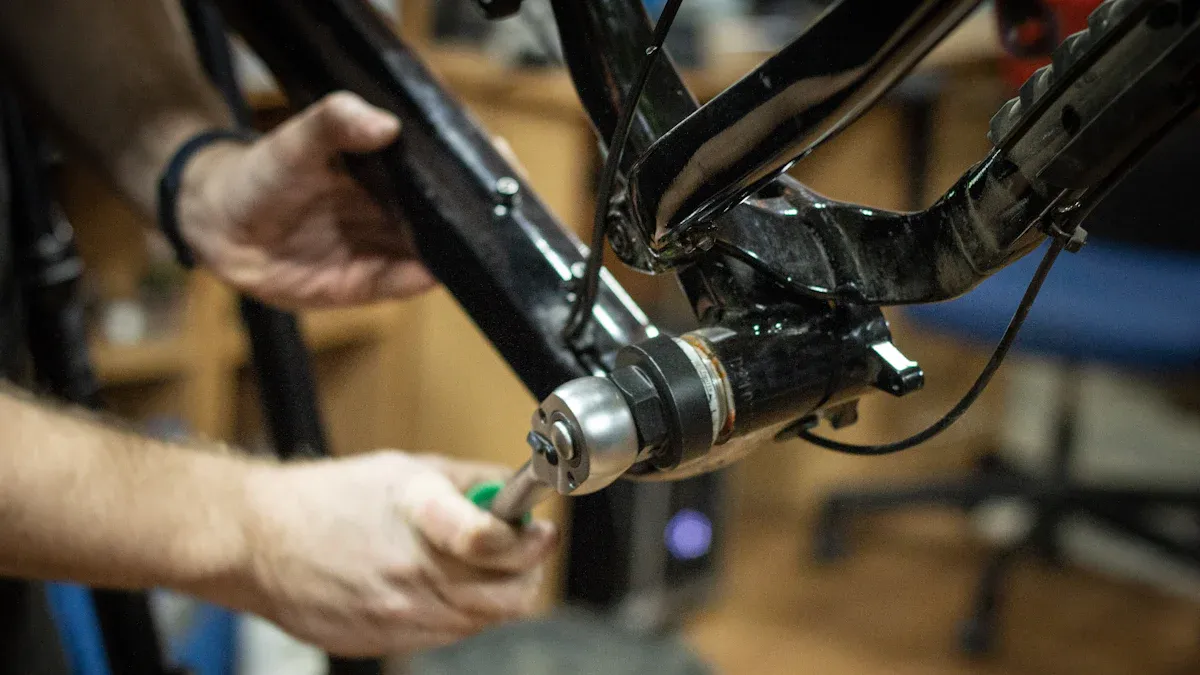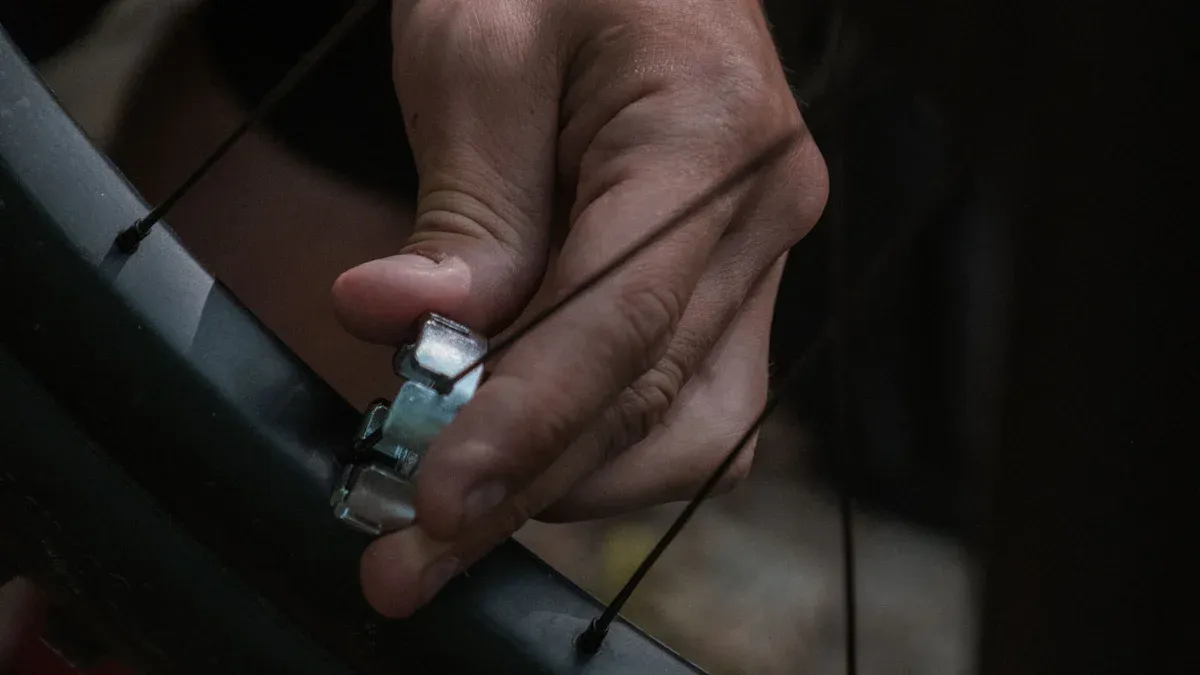
When you ride with a bent bike frame, you compromise both your performance and safety. A bent frame can lead to poor handling, making it harder to steer and control your bike. Plus, it can cause excessive wear on other components, which might lead to a broken bike frame down the line. Don’t ignore this issue! Addressing a bent bike frame quickly can save you from costly repairs and ensure your rides remain smooth and safe.
Key Takeaways
Look at your bike frame often for bends, cracks, or misalignment. This helps keep your rides safe and smooth.
Use easy methods like looking closely and the string test to find frame damage early.
Get the right tools before you try to fix it. You will need a bike stand, wrenches, and a rubber mallet.
Choose whether to fix the frame yourself or get help from a pro. This depends on how bad the damage is.
Always put safety first. If you see serious damage or hear strange noises, ask an expert for advice right away.
Assess Damage

When you suspect your bike frame might be bent, the first step is to assess the damage. You can do this through a couple of straightforward methods: visual inspection and the string test. Let’s break these down.
Visual Inspection
Start with a thorough visual inspection of your bike frame. Look for any noticeable bends, cracks, or dents. Here’s what to check:
Frame Alignment: Stand your bike upright and look down the top tube. Does it appear straight? If it looks off, you might have a bent bike frame.
Welds and Joints: Inspect the welds and joints closely. Any signs of separation or unusual wear can indicate serious issues.
Components: Check how the wheels align with the frame. If they seem misaligned, it’s a sign that you need to assess the damage further.
If you notice anything unusual during your inspection, don’t ignore it! Addressing these issues early can save you from more significant problems later on.
String Test
The string test is a simple yet effective way to assess the damage and check the alignment of your bike frame. Here’s how to do it:
Gather Materials: You’ll need a long piece of string or a straight edge.
Position the String: Attach one end of the string to the rear axle and stretch it towards the front axle. Make sure it’s taut.
Check Alignment: Look at how the string lines up with the frame. It should run parallel to the bike’s geometry. If it doesn’t, your frame might be bent.
This test is a great way to confirm your initial findings from the visual inspection. If both methods suggest that your bike frame is bent, it’s time to consider your repair options.
Tools for Fixing a Bent Bike Frame

When it comes to fixing a bent bike frame, gathering the necessary tools is crucial. Having the right tools on hand can make the repair process smoother and more effective. Let’s dive into the essential tools you’ll need, as well as some optional ones that can help with advanced repairs.
Essential Tools
Here’s a list of the must-have tools for fixing a bent bike frame:
Bike Repair Stand: This tool holds your bike securely while you work on it. It makes repairs much easier and safer.
Wrenches: A set of adjustable wrenches will help you loosen and tighten bolts on your bike frame.
Hammer: A rubber mallet is ideal for gently tapping the frame back into shape without causing further damage.
Measuring Tape: Use this to check the alignment of your frame and ensure everything is straight.
Level: A small level can help you confirm that your bike frame is even after repairs.
Optional Tools
If you want to take your repairs to the next level, consider adding these optional tools to your toolkit:
Frame Alignment Gauge: This tool helps you measure the alignment of your bike frame accurately. It’s especially useful for more complex repairs.
Heat Gun: If you’re working with aluminum or carbon fiber, a heat gun can help soften the material for easier adjustments.
Dremel Tool: This versatile tool can assist in smoothing out rough edges or making precise cuts if needed.
By gathering the necessary tools, you’ll be well-prepared for fixing a bent bike frame. Whether you choose to tackle the repairs yourself or seek professional help, having the right equipment can make all the difference.
Repair Options for a Bent Bike Frame
When you need to fix a bent bike frame, you have two choices: DIY methods or professional repairs. Each choice has its good and bad points, so let’s look at both.
DIY Methods
If you like working on your bike, you might want to fix the bent frame yourself. Here are some ways to straighten it:
Cold Setting Method: This method uses tools to bend the frame back without heat. A frame alignment gauge can help you measure and adjust it correctly. This works best for steel frames because they can bend a little without breaking.
Heat Straightening Method: For aluminum or carbon fiber frames, you may need heat. This softens the material, making it easier to reshape. But be careful! Too much heat can weaken the frame. If you use this method, make sure you control the temperature well.
Using a Hammer: Sometimes, a light tap with a rubber mallet can help fix small bends. Just be careful not to hit too hard, or you might cause more damage.
Frame Alignment Tools: Buying a frame alignment tool can help a lot. These tools show how much adjustment is needed and guide you in fixing the frame correctly.
Before you start, check how bad the damage is. If it looks serious, you might want to think about getting a professional to help.
Professional Repair
If you don’t feel comfortable with DIY methods or if the damage is bad, getting a professional is the best choice. Here’s what to expect:
Expert Evaluation: A professional can check the damage and suggest the best way to fix it. They have the skills and tools to work with different frame materials, like steel, aluminum, or carbon fiber.
Welding and Structural Repairs: If your frame is broken, a professional can decide if welding is needed. They can do repairs that make the frame safe to ride again.
Cost Considerations: Professional repairs can cost more than DIY methods. But they often save you time and give you peace of mind. You won’t have to worry about whether you did it right.
When to Seek Help for a Broken Bike Frame
Signs of Severe Damage
You might wonder when it’s time to consult a professional about your bike frame. Here are some clear signs that indicate you should seek help:
Visible Cracks: If you spot any cracks in the frame, it’s a serious issue. Cracks can lead to complete failure while riding.
Severe Bends: A noticeable bend that you can’t fix with simple methods means you need to consult a professional.
Unusual Noises: If you hear creaking or popping sounds while riding, it could mean your frame is compromised.
Wobbling Wheels: If your wheels wobble or don’t align properly, it’s a sign that your frame might be bent beyond repair.
If you notice any of these signs, don’t hesitate. Consulting a professional bike shop can save you from accidents and further damage.
Cost Considerations
Now, let’s talk about costs. Repairing a broken bike frame can vary widely in price. Here are some factors to consider:
Type of Damage: Minor repairs might cost less than $100, while severe damage could run into the hundreds.
Material of the Frame: Steel frames are often cheaper to repair than aluminum or carbon fiber frames. The latter two require specialized skills and tools, which can increase costs.
DIY vs. Professional: If you choose to fix it yourself, you’ll save money on labor. However, if you’re unsure, it’s best to consult a professional. The peace of mind you get from expert repairs is worth the investment.
In the end, weigh the costs of repairs against the price of a new bike. Sometimes, replacing a broken bike frame might be more economical than fixing it.
In conclusion, a bent bike frame can really change your ride. You should always look for damage and fix it fast. Keep these important points in mind:
Inspect Regularly: Watch your bike frame for any bends or damage.
Choose Repairs Wisely: Think about DIY fixes or getting professional help based on the damage.
Prioritize Safety: Always put your safety first. If you see serious damage, get help right away.
Taking care of your bike frame helps you have a smoother, safer ride. Enjoy cycling! 🚴♂️
FAQ
What should I do if I suspect my bike frame is bent?
If you think your bike frame is bent, start with a visual inspection. Look for any noticeable bends or cracks. Then, perform the string test to check alignment. If you find issues, consider repair options.
Can I ride my bike with a bent frame?
Riding a bike with a bent frame is risky. It can lead to poor handling and increase the chance of accidents. If you notice any damage, it’s best to address it before riding again.
How much does it cost to repair a bent bike frame?
Repair costs vary based on the damage and frame material. Minor repairs might cost under $100, while severe damage could exceed several hundred dollars. Always weigh repair costs against buying a new bike.
How can I prevent my bike frame from bending?
To prevent bending, avoid crashes and rough terrain. Regularly inspect your bike for signs of wear. Proper storage also helps; keep your bike in a safe place away from heavy objects.
Is it worth repairing a bent bike frame?
It depends on the damage and the bike’s value. If the repair costs are less than a new bike, it’s worth fixing. However, if the frame is severely damaged, replacement might be a better option.
See Also
Easy Methods To Keep Your Bike Frame Safe
The Role Of Science In Fixing Carbon Bike Frames
Bike Frame Wrap Makes It Look Brand New
